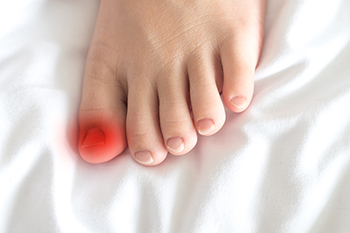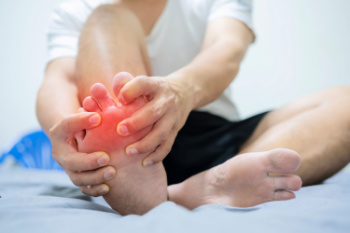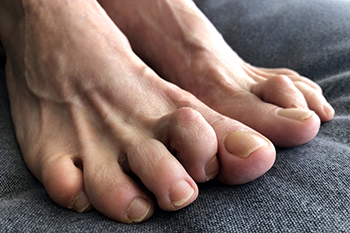Items filtered by date: October 2025
Why That Sore Toe Could Be an Ingrown Toenail

An ingrown toenail occurs when the edge of the toenail grows into the surrounding skin, most often affecting the big toe. Common causes include improper nail trimming, wearing tight footwear, injury, or genetic factors. Symptoms may begin with mild tenderness and progress to redness, swelling, pain, and sometimes infection with pus or drainage. The toe may feel warm and sore to the touch, making walking or wearing shoes uncomfortable. Infections can worsen without treatment, especially for individuals with diabetes or poor circulation. A podiatrist can diagnose an ingrown toenail through a simple exam and determine the best course of treatment. Conservative care may involve lifting the nail edge, or prescribing antibiotics if infection is present. In more severe or recurring cases, a minor in-office procedure can remove part or all of the affected nail. It is suggested that you schedule an appointment with a podiatrist if you experience ongoing pain, swelling, or signs of infection related to your toenail.
Ingrown toenails may initially present themselves as a minor discomfort, but they may progress into an infection in the skin without proper treatment. For more information about ingrown toenails, contact Brain Middleton, DPM of Medical Foot Care Center. Our doctor can provide the care you need to keep you pain-free and on your feet.
Ingrown Toenails
Ingrown toenails are caused when the corner or side of a toenail grows into the soft flesh surrounding it. They often result in redness, swelling, pain, and in some cases, infection. This condition typically affects the big toe and may recur if it is not treated properly.
Causes
- Improper toenail trimming
- Genetics
- Improper shoe fitting
- Injury from pedicures or nail picking
- Abnormal gait
- Poor hygiene
You are more likely to develop an ingrown toenail if you are obese, have diabetes, arthritis, or have any fungal infection in your nails. Additionally, people who have foot or toe deformities are at a higher risk of developing an ingrown toenail.
Symptoms
Some symptoms of ingrown toenails are redness, swelling, and pain. In rare cases, there may be a yellowish drainage coming from the nail.
Treatment
Ignoring an ingrown toenail can have serious complications. Infections of the nail border can progress to a deeper soft-tissue infection, which can then turn into a bone infection. You should always speak with your podiatrist if you suspect you have an ingrown toenail, especially if you have diabetes or poor circulation.
If you have any questions, please feel free to contact our office located in Rome, GA . We offer the newest diagnostic and treatment technologies for all your foot care needs.
Do You Suffer From Painful Feet?
Understanding Pain in the Smaller Toes

Pain in the front of the foot, particularly around the smaller toes, can develop from irritation, overuse, or structural changes in the joints and soft tissues. Wearing tight shoes, high heels, or repetitive stress can inflame the tendons, ligaments, or nerves that support the toes, leading to discomfort or swelling. Sometimes the issue involves joint misalignment or a buildup of pressure beneath the ball of the foot. Advanced imaging such as an MRI scan can help identify hidden causes like soft tissue injury or early joint damage that may not appear on X-rays. Treatment focuses on relieving pressure, improving foot mechanics, and reducing inflammation through custom orthotics, footwear modification, and targeted exercises. If you experience ongoing pain in the lesser toes, it is suggested that you see a podiatrist who can pinpoint the cause and recommend effective options for restoring comfort and balance.
Toe pain can disrupt your daily activities. If you have any concerns, contact Brain Middleton, DPM of Medical Foot Care Center. Our doctor can provide the care you need to keep you pain-free and on your feet.
What Causes Toe Pain?
Most severe toe pain is caused due to a sports injury, trauma from dropping something heavy on the toe, or bumping into something rigid. Other problems can develop over time for various reasons.
Toe pain can be caused by one or more ailments. The most common include:
- Trauma
- Sports injury
- Wearing shoes that are too tight
- Arthritis
- Gout
- Corns and calluses
- Hammertoe
- Bunions
- Blisters
- Ingrown toenails
- Sprains
- Fractures (broken bones)
- Dislocations
When to See a Podiatrist
- Severe pain
- Persistent pain that lasts more than a week
- Signs of infection
- Continued swelling
- Pain that prevents walking
Diagnosis
In many cases the cause of toe pain is obvious, but in others, a podiatrist may want to use more advanced methods to determine the problem. These can range from simple visual inspections and sensation tests to X-rays and MRI scans. Prior medical history, family medical history, and any recent physical traumatic events will all be taken into consideration for a proper diagnosis.
Treatment
Treatments for toe pain and injuries vary and may include shoe inserts, padding, taping, medicines, injections, and in some cases, surgery. If you believe that you have broken a toe, please see a podiatrist as soon as possible.
If you have any questions please contact our office located in Rome, GA . We offer the newest diagnostic and treatment technologies for all your foot and ankle needs.
Common Reasons for Foot Stress Fractures

Foot stress fractures are small cracks in the bones of the feet that develop gradually from repeated stress, rather than a sudden injury. Foot stress fractures often occur when people increase their activity level too quickly, as the foot muscles may not provide enough support to protect the bones. Sports like running, tennis, football, and gymnastics are frequent causes, as repeated impact on hard surfaces places strain on the metatarsals, heel bone, or navicular bone. Abnormal foot structure, such as flat feet or high arches, can also contribute by unevenly distributing pressure. Wearing shoes that lack adequate support or relying heavily on flip-flops may further increase the risk. Pain usually begins gradually, worsening with activity and resulting in swelling or tenderness. A podiatrist can identify the source of the pain and provide proper treatment. If you are experiencing symptoms of foot stress fractures, it is suggested that you make an appointment with a podiatrist for an exam and treatment.
Stress fractures occur when there is a tiny crack within a bone. To learn more, contact Brain Middleton, DPM from Medical Foot Care Center. Our doctor can provide the care you need to keep you pain free and on your feet.
How Are They Caused?
Stress fractures are the result of repetitive force being placed on the bone. Since the lower leg and feet often carry most of the body’s weight, stress fractures are likely to occur in these areas. If you rush into a new exercise, you are more likely to develop a stress fracture since you are starting too much, too soon. Pain resulting from stress fractures may go unnoticed at first, however it may start to worsen over time.
Risk Factors
- Gender – They are more commonly found in women compared to men.
- Foot Problems – People with unusual arches in their feet are more likely to develop stress fractures.
- Certain Sports – Dancers, gymnasts, tennis players, runners, and basketball players are more likely to develop stress fractures.
- Lack of Nutrients – A lack of vitamin D and calcium may weaken the bones and make you more prone to stress fractures
- Weak Bones – Osteoporosis can weaken the bones therefore resulting in stress fractures
Stress fractures do not always heal properly, so it is important that you seek help from a podiatrist if you suspect you may have one. Ignoring your stress fracture may cause it to worsen, and you may develop chronic pain as well as additional fractures.
If you have any questions please contact our office located in Rome, GA . We offer the newest diagnostic and treatment technologies for all your foot and ankle needs.
The Curled Toe Problem

Hammertoe is a common foot deformity where one or more toes bend downward at the middle joint, causing a curled or claw-like appearance. This condition is often caused by a muscle imbalance, wearing tight footwear, injury, or arthritis. Symptoms include pain, swelling, redness, corns or calluses on the affected toe or on the top of the toe. Causes include friction with shoes, and difficulty walking or wearing certain shoes comfortably. The affected toe may feel stiff or sore, and worsen over time, if left untreated. A podiatrist can diagnose hammertoe through a physical examination and imaging, if necessary. Treatment options vary depending on severity, and may include changing footwear, custom orthotics, or, in advanced cases, surgery to correct the deformity. Early intervention can prevent progression and improve comfort. If you notice toe deformities or experience foot pain, it is suggested that you schedule an appointment with a podiatrist to receive a proper diagnosis and appropriate treatment.
Hammertoe
Hammertoes can be a painful condition to live with. For more information, contact Brain Middleton, DPM from Medical Foot Care Center. Our doctor will answer any of your foot- and ankle-related questions.
Hammertoe is a foot deformity that affects the joints of the second, third, fourth, or fifth toes of your feet. It is a painful foot condition in which these toes curl and arch up, which can often lead to pain when wearing footwear.
Symptoms
- Pain in the affected toes
- Development of corns or calluses due to friction
- Inflammation
- Redness
- Contracture of the toes
Causes
Genetics – People who are genetically predisposed to hammertoe are often more susceptible
Arthritis – Because arthritis affects the joints in your toes, further deformities stemming from arthritis can occur
Trauma – Direct trauma to the toes could potentially lead to hammertoe
Ill-fitting shoes – Undue pressure on the front of the toes from ill-fitting shoes can potentially lead to the development of hammertoe
Treatment
Orthotics – Custom made inserts can be used to help relieve pressure placed on the toes and therefore relieve some of the pain associated with it
Medications – Oral medications such as anti-inflammatories or NSAIDs could be used to treat the pain and inflammation hammertoes causes. Injections of corticosteroids are also sometimes used
Surgery – In more severe cases where the hammertoes have become more rigid, foot surgery is a potential option
If you have any questions, please feel free to contact our office located in Rome, GA . We offer the newest diagnostic and treatment technologies for all your foot care needs.


